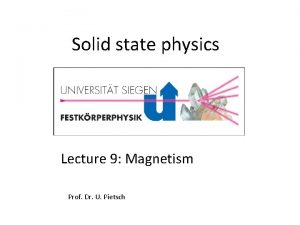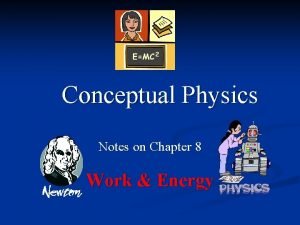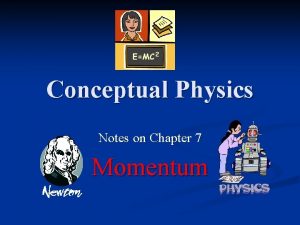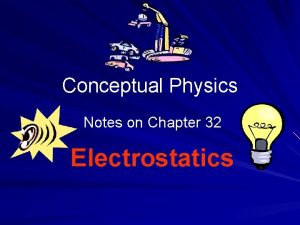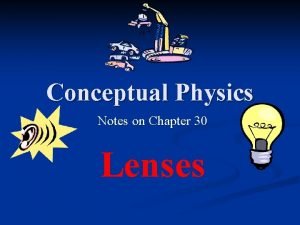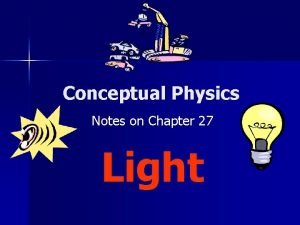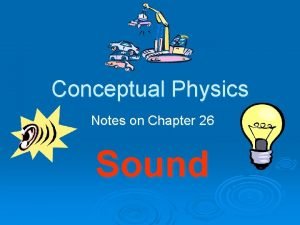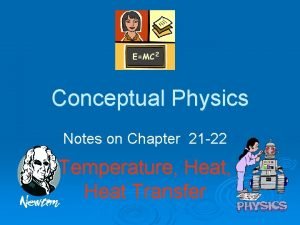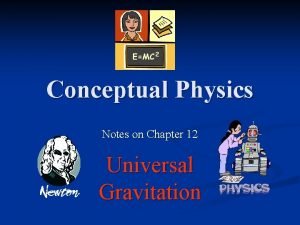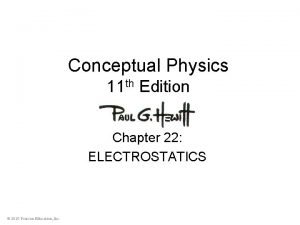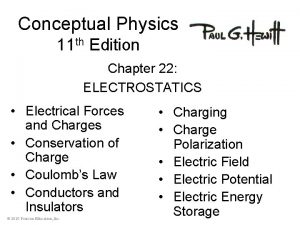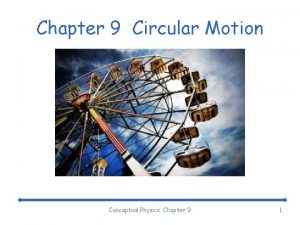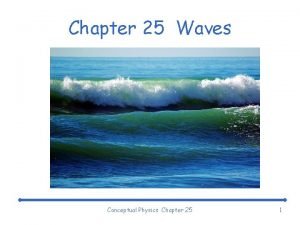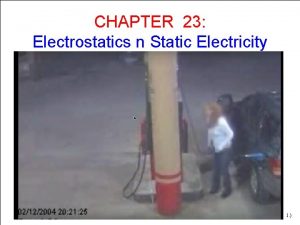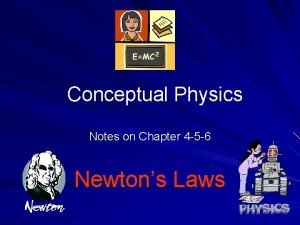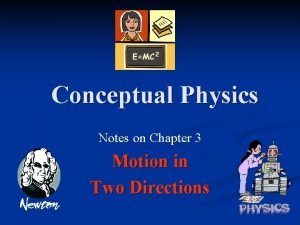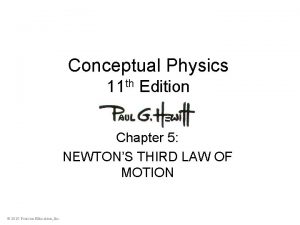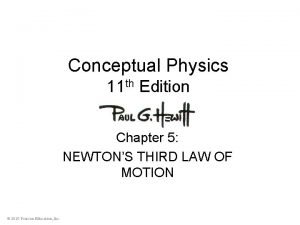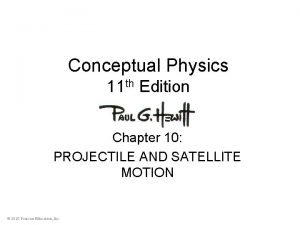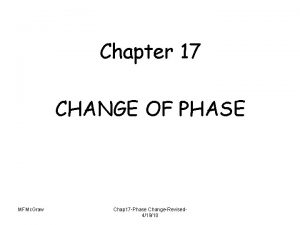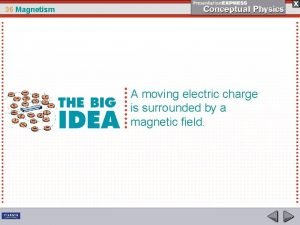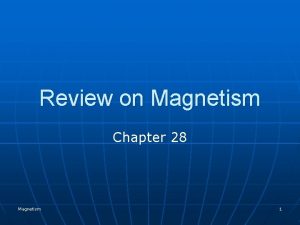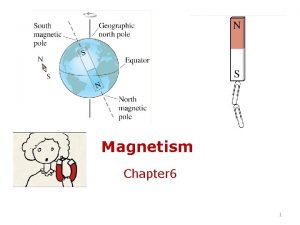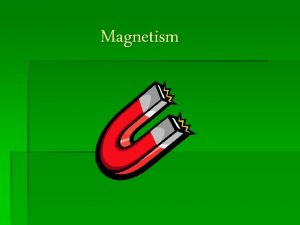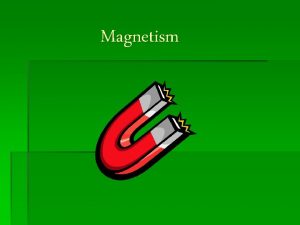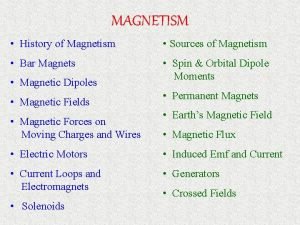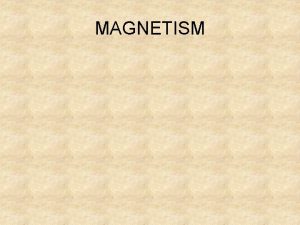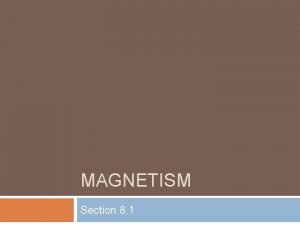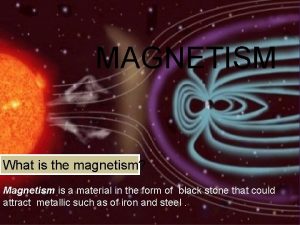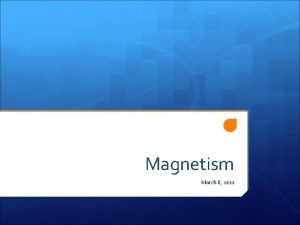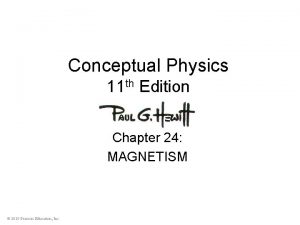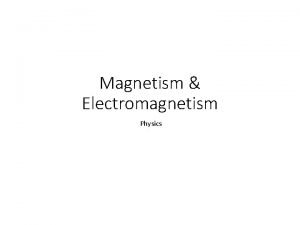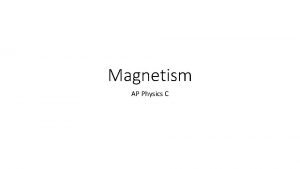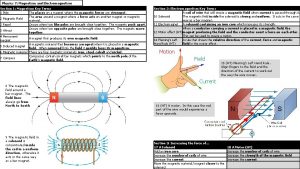Conceptual Physics Chapter 24 MAGNETISM Magnetism n The







































- Slides: 39

Conceptual Physics Chapter 24: MAGNETISM

Magnetism n The term magnetism comes from the name Magnesia, a coastal district of ancient Thessaly, Greece. n Unusual stones, called lodestones, were found by the Greeks more than 2000 years ago. They had the intriguing property of attracting pieces of iron. n Magnets were first fashioned into compasses and used for navigation by the Chinese in the 12 th century.

Magnetic Forces n The force between any two charged particles is described in Coulomb’s law: But Coulomb’s law is not the whole story! n When charged particles are moving with respect to each other, there is a force due to the motion of the charged particles that we call the magnetic force.

Magnetic Poles All magnets have a North and South pole n n North pole (north-seeking pole) South pole (south-seeking pole) Rule for magnetic forces between magnetic poles: n Like poles repel; opposite poles attract.

Magnetic Poles n In all magnets—can’t have one pole without the other n No single pole known to exist Example: n simple bar magnet—poles at the two ends n horseshoe magnet: bent U shape—poles at ends

Magnetic Poles CHECK YOUR NEIGHBOR A weak and strong magnet repel each other. The greater repelling force is by the A. B. C. D. stronger magnet. weaker magnet. Both the same. None of the above.

Magnetic Poles CHECK YOUR NEIGHBOR A weak and strong magnet repel each other. The greater repelling force is by the A. B. C. D. stronger magnet. weaker magnet. Both the same. None of the above. Remember Newton’s Third Law!

Magnetic Fields n Direction (by convention) is North to South n Strength indicated by closeness of the lines n n lines close together; strong magnetic field lines farther apart; weak magnetic field

Magnetic Fields n Produced by two kinds of electron motion n n Electron Spin n main contributor to magnetism n pair of electrons spinning in same direction creates a stronger magnet n pair of electrons spinning in opposite direction cancels magnetic field of the other Electron Revolution

Magnetic Fields CHECK YOUR NEIGHBOR The source of all magnetism is A. B. C. D. electrons rotating around an atomic nucleus. electrons spinning around internal axes. either or both A and B. tiny bits of iron.

Magnetic Fields CHECK YOUR NEIGHBOR The source of all magnetism is A. B. C. D. electrons rotating around an atomic nucleus. electrons spinning around internal axes. either or both A and B. tiny bits of iron.

Magnetic Fields CHECK YOUR NEIGHBOR Where magnetic field lines are more dense, the field there is A. B. C. D. weaker. stronger. Both A and B. Neither A nor B.

Magnetic Fields CHECK YOUR NEIGHBOR Where magnetic field lines are more dense, the field there is A. B. C. D. weaker. stronger. Both A and B. Neither A nor B.

Magnetic Domains Magnetic domains are magnetized clusters of aligned magnetic atoms Permanent magnets are made by: n placing pieces of iron or similar magnetic materials in a strong magnetic field. n stroking material with a magnet to align the domains.

Magnetic Domains Difference between permanent magnet and temporary magnet: • Permanent magnet – Alignment of domains remains once external magnetic field is removed • Temporary magnet – Alignment of domains returns to random arrangement once external magnetic field is removed

Magnetic Domains

Electric Currents & Magnetic Fields Connection between electricity and magnetism n Magnetic field forms a pattern of concentric circles around a current-carrying wire. n When current reverses direction, the direction of the field lines reverse.

Electric Currents & Magnetic Fields

Electric Currents & Magnetic Fields Magnetic field intensity n Increases as the number of loops increase in a currentcarrying coil temporary magnet.

Electric Currents and Magnetic Fields Electromagnet n Iron bar placed in a current-carrying coil n Most powerful—employs superconducting coils that eliminate the core n Applications n n n control charged-particle beams in high-energy accelerators lift automobiles and other iron objects levitate and propel high-speed trains

Electromagnets n An electromagnet is simply a current-carrying coil of wire. n The strength of an electromagnet is increased by n n increasing the current through the coil and increasing the number of turns in the coil. having a piece of iron within the coil. Magnetic domains in the iron core are induced into alignment, adding to the field.

Electromagnets n Electromagnets that utilize superconducting coils produce extremely strong magnetic fields —and they do so very economically because there are no heat losses.

Giant electromagnets are used to move scrap metal at a construction site. The Large Hadron Collider (LHC) uses more than 50 types of electromagnets to accelerate sub -atomic particles to 99. 9% the speed of light.

Electric Currents and Magnetic Fields CHECK YOUR NEIGHBOR An electromagnet can be made stronger by A. B. C. D. Increasing the number of turns of wire. Increasing the current in the coil. Both A and B. None of the above.

Electric Currents and Magnetic Fields CHECK YOUR NEIGHBOR An electromagnet can be made stronger by A. B. C. D. Increasing the number of turns of wire. Increasing the current in the coil. Both A and B. None of the above.

Magnetic Forces on Moving Charges Moving charges in a magnetic field experience a deflecting force. • Greatest force – when particle movement in direction perpendicular to the magnetic field lines • Least force - particle movement other than perpendicular to the magnetic field lines • No force - particle movement parallel to the magnetic field lines

Magnetic Forces on Moving Charges Moving charges in a magnetic field experience a deflecting force. (continued)

Magnetic Force on Moving Charges CHECK YOUR NEIGHBOR The magnetic force on a moving charged particle can change the particle’s A. B. C. D. Speed. Direction. Both A and B. Neither A nor B.

Magnetic Force on Moving Charges CHECK YOUR NEIGHBOR The magnetic force on a moving charged particle can change the particle’s A. B. C. D. Speed. Direction. Both A and B. Neither A nor B.

Magnetic Force on Moving Charges CHECK YOUR NEIGHBOR The reason that an electron moving in a magnetic field doesn’t pick up speed is A. B. C. D. Magnets only divert them. Only electric fields can change the speed of a charged particle. The magnetic force is always perpendicular to its motion. All of the above.

Magnetic Force on Moving Charges CHECK YOUR NEIGHBOR The reason that an electron moving in a magnetic field doesn’t pick up speed is A. B. C. D. Magnets only divert them. Only electric fields can change the speed of a charged particle. The magnetic force is always perpendicular to its motion. All of the above.

Magnetic Force on Current- Carrying Wires n Current of charged particles moving through a magnetic field experiences a deflecting force. n n Direction is perpendicular to both magnetic field lines and current (perpendicular to wire). Strongest when current is perpendicular to the magnetic field lines.

Magnetic Force on Current- Carrying Wires Electric meters detect electric current Example: • • magnetic compass in a coil of wires

Magnetic Force on Current- Carrying Wires Galvanometer n n n Current-indicating device named after Luigi Galvani Called ammeter when calibrated to measure current Called voltmeter when calibrated to measure electric potential

Magnetic Force on Current- Carrying Wires Electric motor

Earth’s Magnetic Field n Earth is itself a huge magnet. n The magnetic poles of Earth are widely separated from the geographic poles. n The magnetic field of Earth is not due to a giant magnet in its interior—it is due to electric currents. n Earth’s magnetic field reverses direction: 20 reversals in last 5 million years.

Earth’s Magnetic Field n Universe is a shooting gallery of charged particles called cosmic rays. n Cosmic rays are deflected away from Earth by Earth’s magnetic field. n Some of them are trapped in the outer reaches of Earth’s magnetic field and make up the Van Allen radiation belts

Earth’s Magnetic Field n Disturbances in Earth’s field often allow the ions to dip into the atmosphere, causing it to glow like a fluorescent lamp. Hence the aurora borealis or aurora australis.

Biomagnetism n Certain bacteria biologically produce single-domain grains of magnetite (a compound equivalent to iron ore) that they string together to form internal compasses. n n n They then use these compasses to detect the dip of Earth’s magnetic field. Equipped with a sense of direction, the organisms are able to locate food supplies. Pigeons have multiple domain magnetite magnets within their skulls that are connected with a large number of nerves to the pigeon brain. n n Pigeons have a magnetic sense, and not only can they discern longitudinal directions along Earth’s magnetic field, they can also detect latitude by the dip of Earth’s field. Other similar animals: Bees, butterflies, sea turtles and fish.
 Chapter 24 magnetism magnetic fundamentals answers
Chapter 24 magnetism magnetic fundamentals answers Physics 102 electricity and magnetism
Physics 102 electricity and magnetism Ib physics chapter 5
Ib physics chapter 5 Magnetism in solid state physics
Magnetism in solid state physics Conceptual physics notes
Conceptual physics notes Conceptual physics momentum
Conceptual physics momentum Conceptual physics chapter 35 electric circuits
Conceptual physics chapter 35 electric circuits Chapter 33 electric fields and potential
Chapter 33 electric fields and potential Conceptual physics electrostatics
Conceptual physics electrostatics Chapter 30 lenses
Chapter 30 lenses Chapter 27 light conceptual physics
Chapter 27 light conceptual physics Conceptual physics chapter 26
Conceptual physics chapter 26 Conceptual physics chapter 21
Conceptual physics chapter 21 Conceptual physics chapter 13 universal gravitation
Conceptual physics chapter 13 universal gravitation Conceptual physics momentum
Conceptual physics momentum Conceptual physics chapter 22 answers
Conceptual physics chapter 22 answers Conceptual physics chapter 22 electrostatics
Conceptual physics chapter 22 electrostatics Chapter 9 circular motion answers
Chapter 9 circular motion answers Conceptual physics chapter 25
Conceptual physics chapter 25 Electricity
Electricity Conceptual physics notes
Conceptual physics notes Conceptual physics notes
Conceptual physics notes Slightly tilted wings of airplanes deflect
Slightly tilted wings of airplanes deflect Slightly tilted wings of airplanes deflect
Slightly tilted wings of airplanes deflect Conceptual physics chapter 3 linear motion
Conceptual physics chapter 3 linear motion Tossed ball conceptual physics answers
Tossed ball conceptual physics answers Conceptual physics chapter 17 change of phase answers
Conceptual physics chapter 17 change of phase answers Chapter 36 magnetism answer key
Chapter 36 magnetism answer key Why does it happen
Why does it happen University physics with modern physics fifteenth edition
University physics with modern physics fifteenth edition Physics ib ia examples
Physics ib ia examples Hát kết hợp bộ gõ cơ thể
Hát kết hợp bộ gõ cơ thể Frameset trong html5
Frameset trong html5 Bổ thể
Bổ thể Tỉ lệ cơ thể trẻ em
Tỉ lệ cơ thể trẻ em Voi kéo gỗ như thế nào
Voi kéo gỗ như thế nào Chụp phim tư thế worms-breton
Chụp phim tư thế worms-breton Hát lên người ơi
Hát lên người ơi Kể tên các môn thể thao
Kể tên các môn thể thao Thế nào là hệ số cao nhất
Thế nào là hệ số cao nhất



